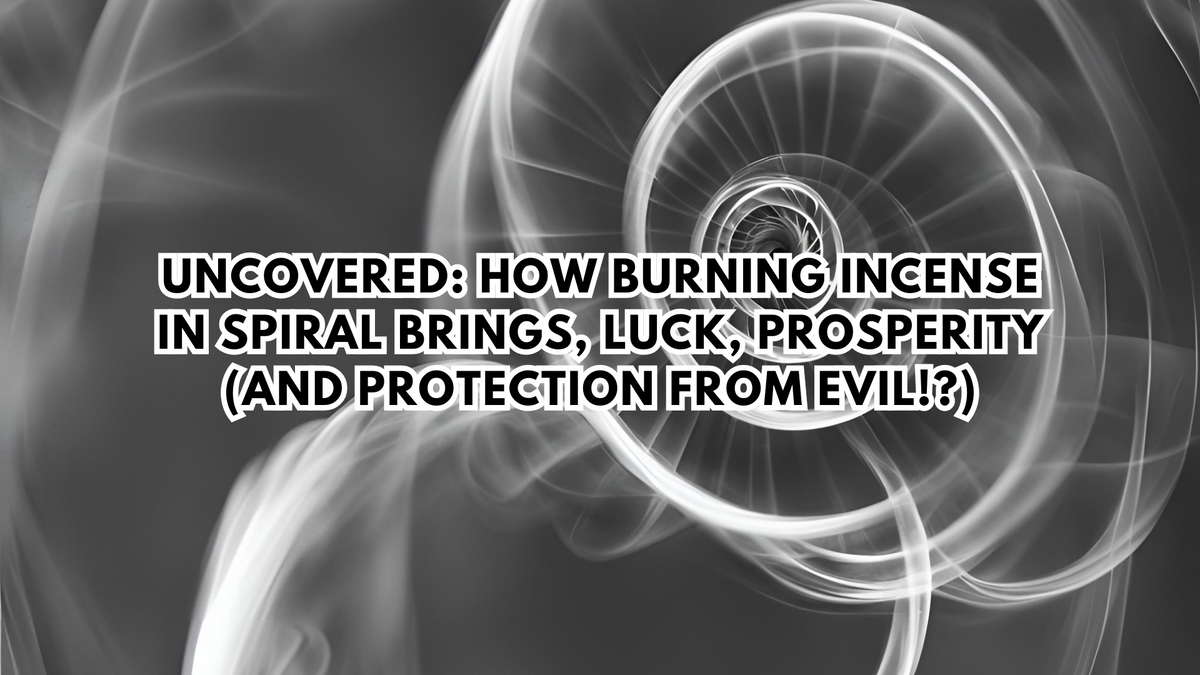
UNCOVERED: How Burning Incense In Spiral Brings, Luck, Prosperity (and protection from evil!?)
|
|
Time to read 6 min
 My Account
My Account
|
|
Time to read 6 min
Imagine the enchanting fragrance of incense burning in a spiral, curling and twisting as it dances through the air, creating a mesmerizing pattern of smoke.
Incense burning has been a mystical and spiritual practice shrouded in ancient wisdom and symbolism for ages.
In this journey, we’ll unravel the secrets behind the captivating art of spiral incense burning and explore its science, spiritual significance, cultural interpretations, and practical uses.
The captivating spiral shape of incense ash results from a blend of factors. These include:
Bamboo stick binding
Heat curling
Air movement
The dipping process
These everyday elements unite to form a visually enticing experience, providing profound insights into our spiritual state.
The behavior of incense ash can often provide revelations, which signal the necessity for cleansing or the existence of positive energy within a space.
The role of bamboo sticks in forming the spiral incense ash is quite intriguing. The bamboo culm, specifically Bambusa tulda, is bent into a spiral shape. This allows the incense to burn in a unique, visually appealing pattern.
Moreover, the direction of ash curling, whether downward or upward, bears spiritual implications. Downward curls are seen as negative omens, while upward curls symbolize positive energy and blessings.
The dipping process of incense sticks involves:
Submerging them in a liquid mix, such as dipropylene glycol or a fragrance oil blend, for at least 24 hours
Air movement influences this process, affecting the drying time, fragrance dispersion, and curled incense formation
The climate and humidity levels can also impact the drying time and chemical composition of the incense, ultimately influencing the burn pattern and mode of an incense stick
Spiral incense burning occupies a significant position in spiritual practices. Different cultures interpret the spiritual meanings of incense ash in various ways, such as symbolizing luck and prosperity, warding off evil spirits, or providing spiritual cleansing.
This practice also signifies divine presence, fulfillment of prayers, and the quest for clarity or guidance. Some even use incense ash in divination practices, from predicting romance to receiving answers to specific questions.
Burning spiral incense can represent a link with the spiritual realm. The spiraling smoke is believed to symbolize the spiritual meaning of the presence of spirit beings, divine energy, or a powerful force at work.
By implication, the practice represents an acknowledgment of the practitioner's prayers. When incense ash curls upward, it’s often seen as a sign that prayers have been answered and desires granted.
Spiral incense stick burning can also represent the quest for clarity and guidance in one’s spiritual journey. This mystical practice has its roots in ancient civilizations like Egypt and Babylon, where incense burning was used for communication with divine forces and gaining spiritual insights.
The interpretation of incense ash signs, such as incense ash curling, incense ash curl, spiraling, or splitting into two, can provide valuable guidance or warnings. However, the specific guidance depends on individual beliefs and cultural traditions.
Therefore, understanding incense ash curling meaning is essential. In particular, observing the incense ash curling upward can intriguing for those who practice this ancient art.
For example, Chinese culture associates spiral incense burning with energy cleansing, communication with the divine, protection, and relaxation. In contrast, it is often used in temples as an offering and for worship in the Indian culture.
Create The Perfect Mood On Demand With These Hand-Dipped Incense Sticks
In certain cultures, burning spiral incense is believed to draw fortune and prosperity. It is said to accomplish this through the harmonious equilibrium of mind, body, and spirit. The spiral shape symbolizes the continuous flow of energy and the cyclical nature of life, which encourages abundance and prosperity.
Other cultural beliefs link spiral incense burning with protection from malevolent spirits and negative energies. Burning incense during religious ceremonies is believed to ward off evil spirits and purify the area.
In some Muslim and Asian cultures, spiral incense burning is used to keep away evil spirits. By implication, spiral incense burning is an essential component of their spiritual practices.
Incense ash is more than just a byproduct of an enchanting ritual, as it also has practical applications. For instance, it can serve as a fertilizer for plants, an insecticide, and a tool for spiritual cleansing. Additionally, incense ash hanging can be a visually appealing way to display the remnants of your rituals, with incense ash not falling and creating a mess.
In some cases, people even collect incense ashes for various purposes, such as when incense ashes burn for a unique visual effect. These practical applications showcase the versatility of incense ash and its significance beyond spiritual practices.
Incense ash, particularly from natural sources, can be an excellent fertilizer for plants, promoting their growth and health. It contains essential nutrients like potassium, phosphorus, and calcium, which help plants thrive.
However, using incense ash as fertilizer should be done with caution, as excessive amounts can burn the roots. A safe approach is to mix a couple of tablespoons of incense ash with a gallon of water and then apply. For best results, this process should be done once a month.
Incense ash from coniferous trees, like cedarwood, can serve as an insecticide. The rationale behind this use is the antiseptic, astringent, and insect-repellent properties of incense ash.
Some of the pests that can be repelled or controlled with incense ash include:
mosquitoes
moths
woodworm
rats
mice
What's more, cedarwood incense ash is frequently employed in spiritual cleansing rituals due to its purifying characteristics.
Proper disposal of incense ash is necessary to evade possible health risks and environmental dangers. Burying incense ash in the ground is the safest bet, as it prevents the accidental inhalation or ingestion of the toxic heavy metals and oxides present in the ash. Regardless of the disposal method, always handle incense ash carefully, and avoid breathing it in directly.